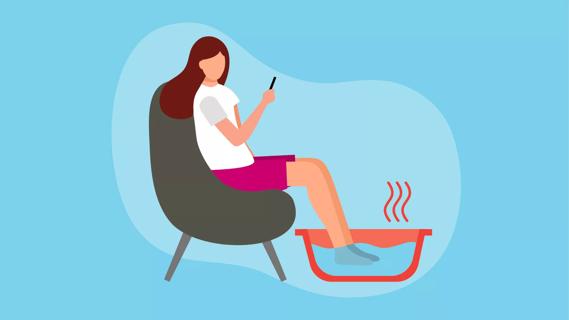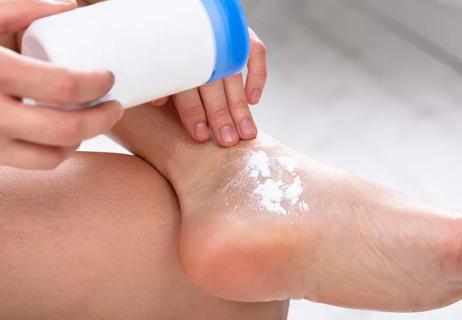You might have plantar fasciitis, Achilles tendinitis or arthritis

It might be a sharp, stinging pain that runs along the bottom of your foot. Or maybe your heels feel tight or the top of your feet throb when you wake up. If your feet hurt in the morning, you may be wondering if you’re just getting up on the wrong side of the bed or if it’s something to be worried about.
Advertisement
Cleveland Clinic is a non-profit academic medical center. Advertising on our site helps support our mission. We do not endorse non-Cleveland Clinic products or services. Policy
According to podiatrist Dina Stock, DPM, foot pain or heel pain in the morning can be caused by a number of conditions due to lack of support or overused tendons or ligaments.
Here are four common conditions that might be causing you pain first thing in the morning and how you can handle them.
If you stand for long periods of time or you’re an athlete who hits the ground running, this is a common condition you might face. Your feet have ligaments called plantar fascia that stretch from your heel to the base of your toes. These ligaments support the arch of your foot and absorb pressure as you walk or run. When these ligaments become inflamed or tear, you develop a condition called plantar fasciitis.
“When you step down, you have a sharp pain in the affected area,” says Dr. Stock. “One of the things you want to do is get more flexibility into that area.”
This is the most common condition that leads to heel pain first thing in the morning. It may feel very tight in your heel and you can experience a sharp pain very quickly once you step out of bed and take a few steps after you get out of bed. Often, this pain will go away on its own the more you walk and wake up those ligaments, but sometimes, this pain can linger all day. To help alleviate that pain, Dr. Stock suggests stretching in bed when you first wake up before putting your feet down on the ground.
Advertisement
You can do this by wrapping a towel or elastic band around your forefoot and pulling your foot gently toward you. Hold that position for 20 seconds, then relax, and repeat that stretch five to 10 times before getting out of bed. You should continue stretching throughout the day.
Similar to plantar fasciitis, Achilles tendinitis happens when your Achilles tendon on the back of your heel becomes inflamed or irritated. This tendon helps you run, walk and jump, but if your Achilles tendon is overstressed or overused, it can become stiff, tender and swell. You can experience pain in your heel first thing in the morning, but you may also experience pain when you’re exercising, climbing stairs or moving throughout the day. If left untreated, you may feel like it’s difficult to walk.
To help alleviate pain, you should rest, ice your tendon for up to 20 minutes at a time throughout the day, and reduce swelling by elevating your leg. If pain continues, your doctor can provide anti-inflammatory medication or you may need to be immobilized. There are some surgical procedures you can have, too, if pain persists and isn’t responsive to conservative treatment.
“The treatment for Achilles tendinitis is largely the same as plantar fasciitis,” notes Dr. Stock.
About 2 out of 10 people have flat feet — and many people who have them don’t experience any issues. If you have flat feet, maybe you never developed an arch, or as an adult, your arch has fallen. This can happen if you experience inflammation or a tear in a leg tendon that supports your arches.
“You want to accommodate the foot so you don’t make all these other structures overwork,” says Dr. Stock. “Instability in your foot can lead to a lot of different conditions with your tendons, ligaments and joints, so supporting the arches is the most important thing you can do if you have a flat foot.”
Flat feet can aggravate other conditions like plantar fasciitis or Achilles tendinitis. So, it’s important to support your feet by wearing good running sneakers or using inserts in your shoes for additional support. You can also strengthen your fallen arches or flat feet with a number of stretches and exercises like arch lifts and heel raises.
And if you have flat feet, you should stay away from wearing sandals or walking around barefoot.
If you’re feeling pain in the morning along the top of your foot or in your ankles, you may have arthritis. Arthritis occurs when your cartilage wears away and your joints rub together, bone on bone. This can happen with regular wear and tear as you age (osteoarthritis). You can also have rheumatoid arthritis or psoriatic arthritis, which are caused by inflammation.
Advertisement
“It’s important to differentiate what type of arthritis you have,” says Dr. Stock. “If you have inflammatory arthritis, you have to decrease the inflammation in your body.”
If you experience foot pain in the morning, try stretching before you get out of bed and throughout the day. You may also want to consider wearing a night splint to help position your affected foot at a 90-degree angle while you sleep. This can help stretch your tightened muscles and ligaments. Refraining from sleeping on your belly and letting your feet lay flat can also be helpful.
If you’ve tried stretching, wearing better sneakers and/or using inserts in your footwear and continue experiencing pain, you may want to schedule an appointment with your doctor. And if you have any visual swelling or change in skin color, or if your foot feels warm to the touch, you should make an appointment immediately because you may have torn a ligament or tendon.
“A lot of times, if your pain is mild or moderate, the first thing we’re going to do is change your support, recommend a stretching protocol, provide icing recommendations and activity modification,” says Dr. Stock.
Advertisement
Learn more about our editorial process.
Advertisement

Home remedies are unlikely to cure your contagious foot fungus — and they might even make it worse

If soaking your feet, disinfecting your shoes and making lifestyle changes don’t do the job, it’s time to talk to a doctor

Genetics, hormones, medications and stress are just a few reasons your feet could be extra funky

Try stretching, massage, elevation and a supportive pair of shoes to help relieve foot aches and pains

Footwear that offers cushioning plus heel and arch support can help you relieve and manage symptoms

Except in certain medical scenarios, foot health experts rarely recommend foot soaks

Rethink your exercise routine to maintain — and maybe even gain — fitness during recovery

Sweat plus bacteria equals sour-smelling feet

If you’re feeling short of breath, sleep can be tough — propping yourself up or sleeping on your side may help

If you fear the unknown or find yourself needing reassurance often, you may identify with this attachment style

If you’re looking to boost your gut health, it’s better to get fiber from whole foods